Foreword / YouTube Video Review
The review on this website is a brief overview and summary of the objective performance of this speaker. It is not intended to be a deep dive. Moreso, this is information for those who prefer “just the facts” and prefer to have the data without the filler.
However, for those who want more - a detailed explanation of the objective performance, and my subjective evaluation (what I heard, what I liked, etc.) - please watch the below video where I go more in-depth.
Information and Photos
Klipsch’s The Fives is a compact powered 2-way speaker featuring a 4.5-inch midwoofer and 1-inch dome tweeter on Klipsch’s “TRACTRIX” horn. It comes with a variety of hookup options (HDMI ARC, Bluetooth, optical toslink, Turntable and RCA connections. It also comes with a remote control. The below is from the manufacturer’s website:
Enjoy superior stereo sound from a powerful and beautifully crafted tabletop system. With virtually endless connection possibilities, including HDMI-ARC, The Fives provide a better listening experience than a traditional sound bar with the same easy plug-and-play setup. Award-winning acoustics, state-of-the-art DSP, and tuning alongside discrete left and right channels, the Fives feature removable magnetic grilles, multiple finish options, and a subwoofer output. The Fives are the most versatile speakers on Earth.
MSRP is about $799 USD for a pair. However, as of this very moment they are on sale for $699/pair.
The Fives feature a built-in DSP which allows for (3) different response profiles:
- Dynamic Bass EQ
- Flat
- Bass Cut
My speakers arrived with only the first two modes available. The latter “bass cut” profile is available via a firmware update (link). In my research, this mode was provided in response to owners’ complaints about bloated bass. Ironically, the “flat” mode is not flat, while the “bass cut” mode is closer to flat. More on this later.
The Fives come in black and walnut with a removable grille.
CTA-2034 (SPINORAMA) and Accompanying Data
All data collected using Klippel’s Near-Field Scanner. The Near-Field-Scanner 3D (NFS) offers a fully automated acoustic measurement of direct sound radiated from the source under test. The radiated sound is determined in any desired distance and angle in the 3D space outside the scanning surface. Directivity, sound power, SPL response and many more key figures are obtained for any kind of loudspeaker and audio system in near field applications (e.g. studio monitors, mobile devices) as well as far field applications (e.g. professional audio systems). Utilizing a minimum of measurement points, a comprehensive data set is generated containing the loudspeaker’s high resolution, free field sound radiation in the near and far field. For a detailed explanation of how the NFS works and the science behind it, please watch the below discussion with designer Christian Bellmann:
A picture of the setup in my garage:
The reference plane in this test is the tweeter. A single RCA input was used and the volume was set to about 3/4 max. No grille was used and the ports were open (not stuffed).
Note about DSP Mode: I initially auditioned and subsequently tested these speakers in “Flat” DSP mode. Upon seeing the results and finishing up my review, I was informed there was a firmware update which enabled a new mode: “bass cut”. Contrary to the naming convention, “flat” was not flat and “bass cut” was a flatter bass response. I much preferred the “bass cut” mode subjectively. Therefore, I performed another round of objective testing using this mode. In this review I have provided results using “bass cut” mode. However, I do provide a single set of SPIN data using the “flat” mode. The title of each graph tells you which mode was enabled. I did no testing with the “Dynamic EQ” mode enabled.
Measurements are provided in a format in accordance with the Standard Method of Measurement for In-Home Loudspeakers (ANSI/CTA-2034-A R-2020). For more information, please see this link.
CTA-2034 / SPINORAMA:
The On-axis Frequency Response (0°) is the universal starting point and in many situations, it is a fair representation of the first sound to arrive at a listener’s ears.
The Listening Window is a spatial average of the nine amplitude responses in the ±10º vertical and ±30º horizontal angular range. This encompasses those listeners who sit within a typical home theater audience, as well as those who disregard the normal rules when listening alone.
The Early Reflections curve is an estimate of all single-bounce, first-reflections, in a typical listening room.
Sound Power represents all the sounds arriving at the listening position after any number of reflections from any direction. It is the weighted rms average of all 70 measurements, with individual measurements weighted according to the portion of the spherical surface that they represent.
Sound Power Directivity Index (SPDI): In this standard the SPDI is defined as the difference between the listening window curve and the sound power curve.
Early Reflections Directivity Index (EPDI): is defined as the difference between the listening window curve and the early reflections curve. In small rooms, early reflections figure prominently in what is measured and heard in the room so this curve may provide insights into potential sound quality.
“Flat” DSP Mode:
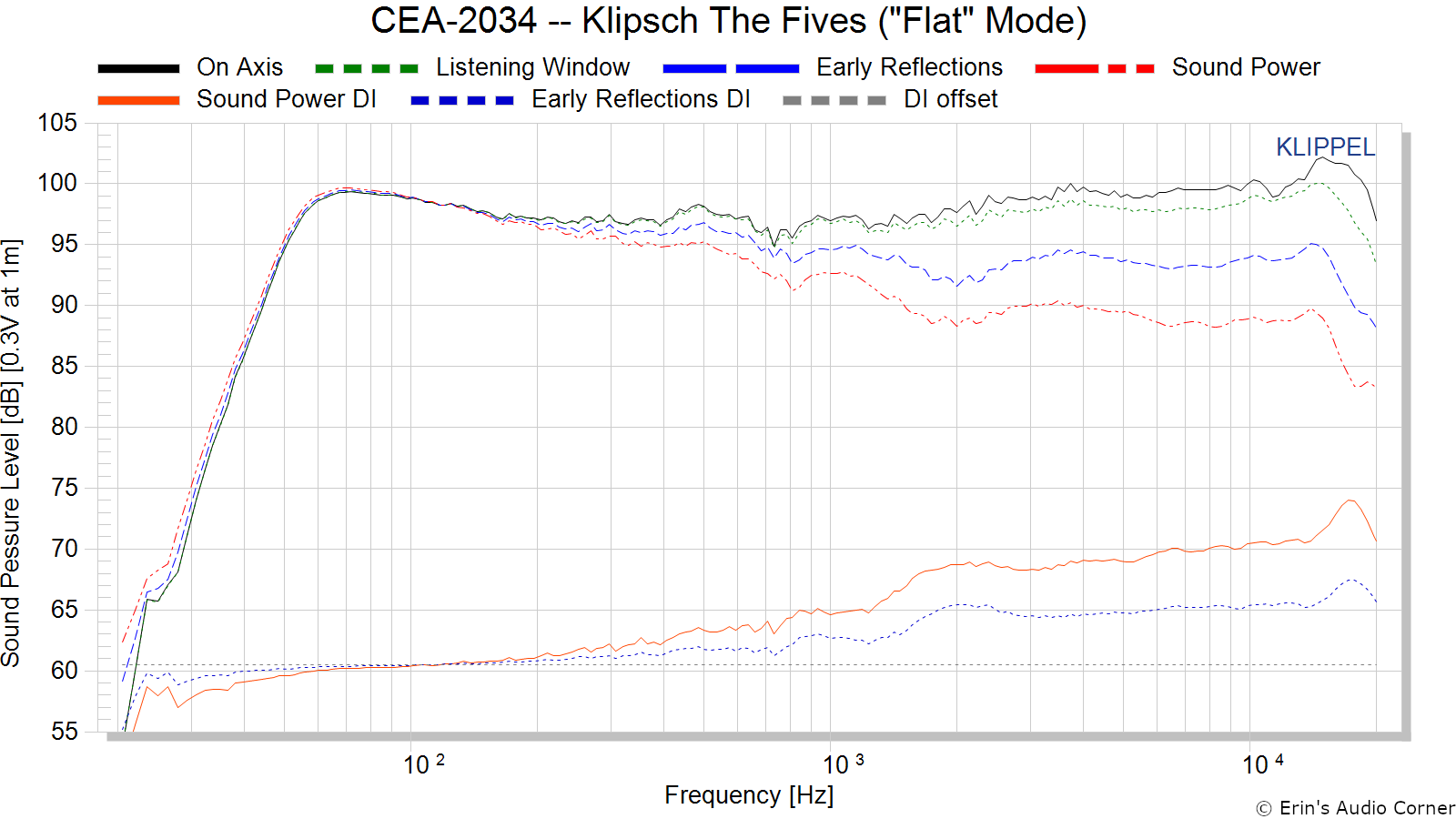
“Bass Cut” DSP Mode:
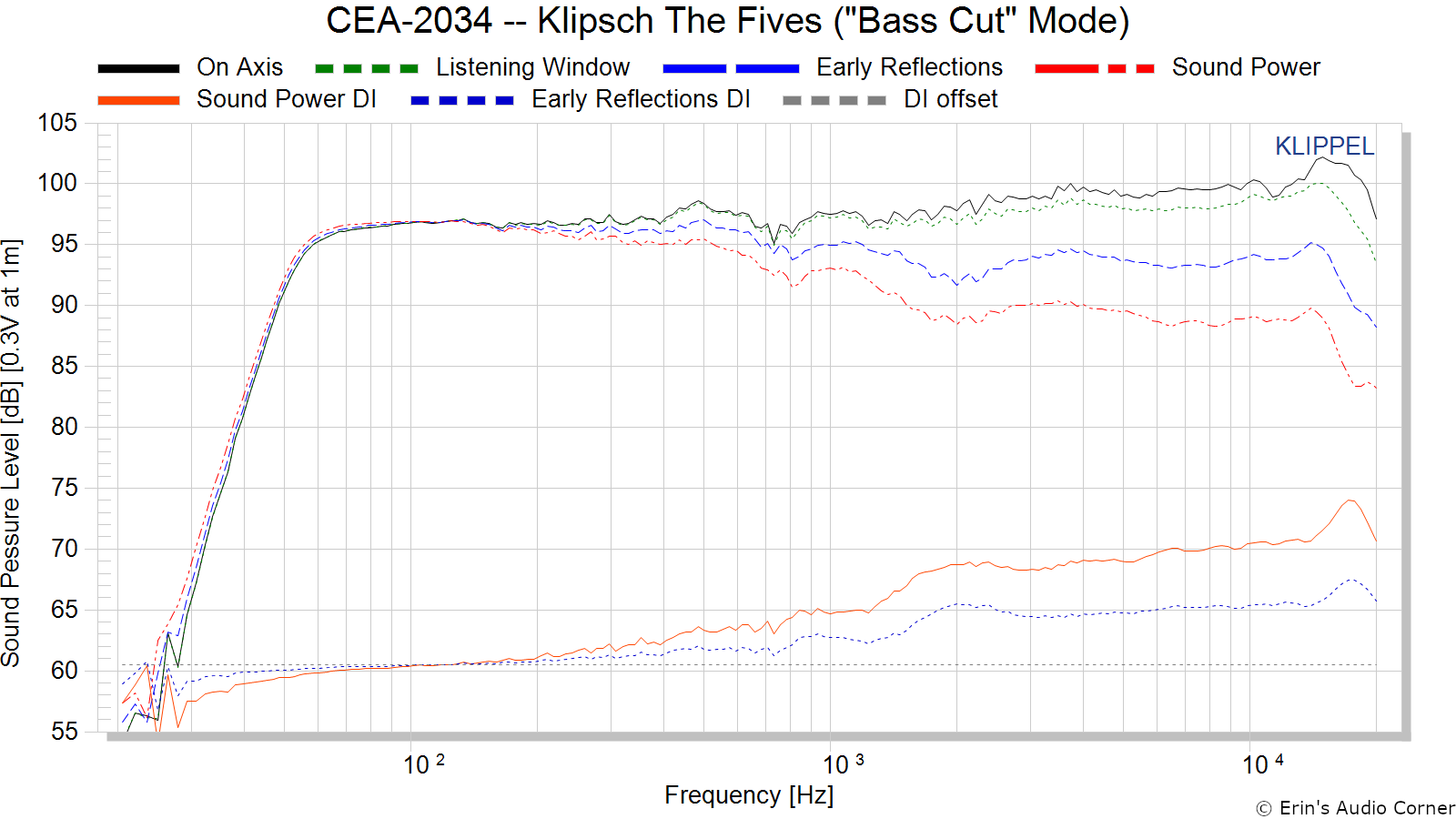
Early Reflections Breakout:
Floor bounce: average of 20º, 30º, 40º down
Ceiling bounce: average of 40º, 50º, 60º up
Front wall bounce: average of 0º, ± 10º, ± 20º, ± 30º horizontal
Side wall bounces: average of ± 40º, ± 50º, ± 60º, ± 70º, ± 80º horizontal
Rear wall bounces: average of 180º, ± 90º horizontal
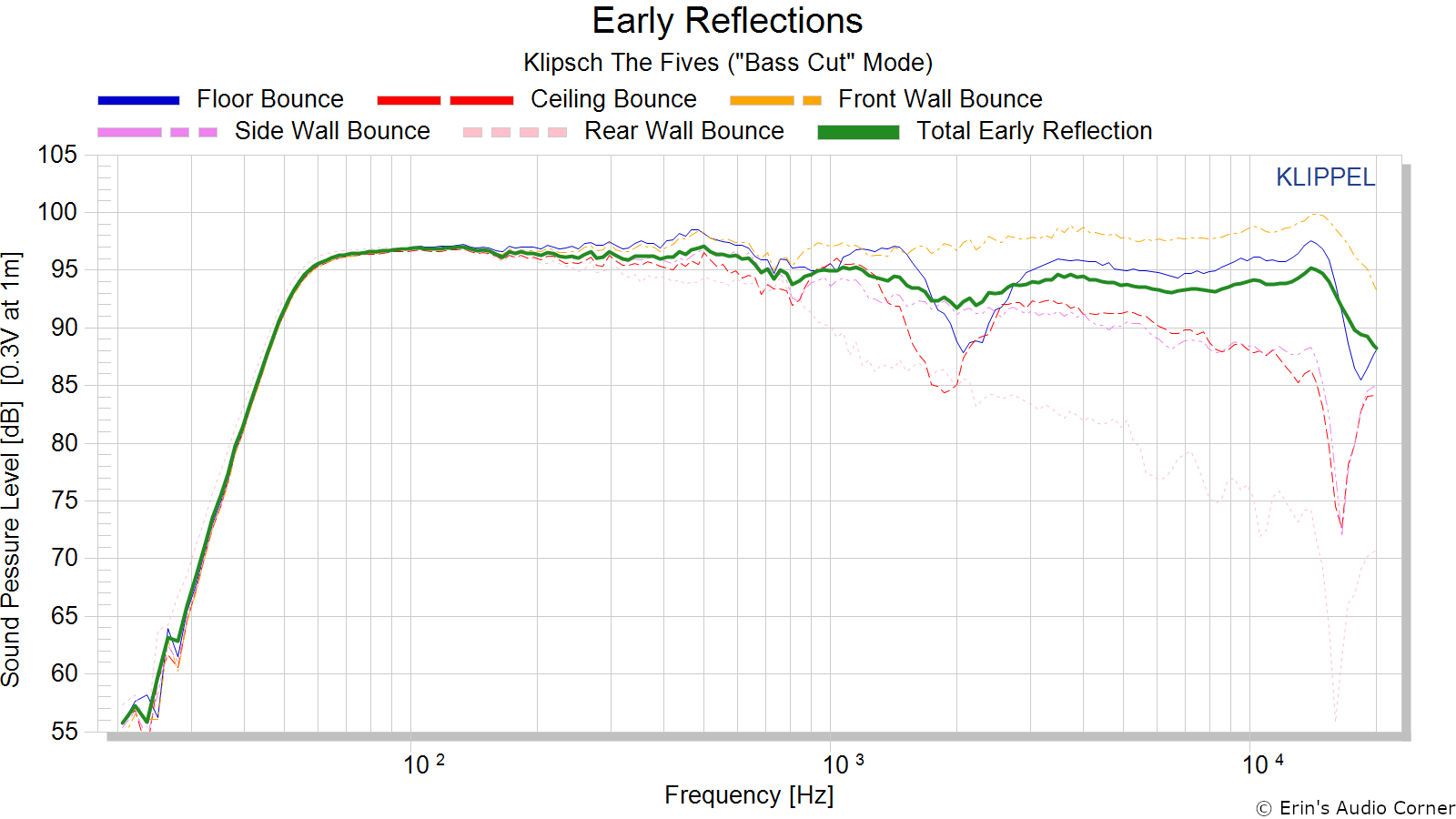
Estimated In-Room Response:
In theory, with complete 360-degree anechoic data on a loudspeaker and sufficient acoustical and geometrical data on the listening room and its layout it would be possible to estimate with good precision what would be measured by an omnidirectional microphone located in the listening area of that room. By making some simplifying assumptions about the listening space, the data set described above permits a usefully accurate preview of how a given loudspeaker might perform in a typical domestic listening room. Obviously, there are no guarantees because individual rooms can be acoustically aberrant. Sometimes rooms are excessively reflective (“live”) as happens in certain hot, humid climates, with certain styles of interior décor and in under-furnished rooms. Sometimes rooms are excessively “dead” as in other styles of décor and in some custom home theaters where acoustical treatment has been used excessively. This form of post processing is offered only as an estimate of what might happen in a domestic living space with carpet on the floor and a “normal” amount of seating, drapes, and cabinetry.
For these limited circumstances it has been found that a usefully accurate Predicted In-Room (PIR) amplitude response, also known as a “room curve” is obtained by a weighted average consisting of 12 % listening window, 44 % early reflections and 44 % sound power. At very high frequencies errors can creep in because of excessive absorption, microphone directivity, and room geometry. These discrepancies are not considered to be of great importance.

Horizontal Frequency Response (0° to ±90°):

Vertical Frequency Response (0° to ±40°):

Horizontal Contour Plot (not normalized):
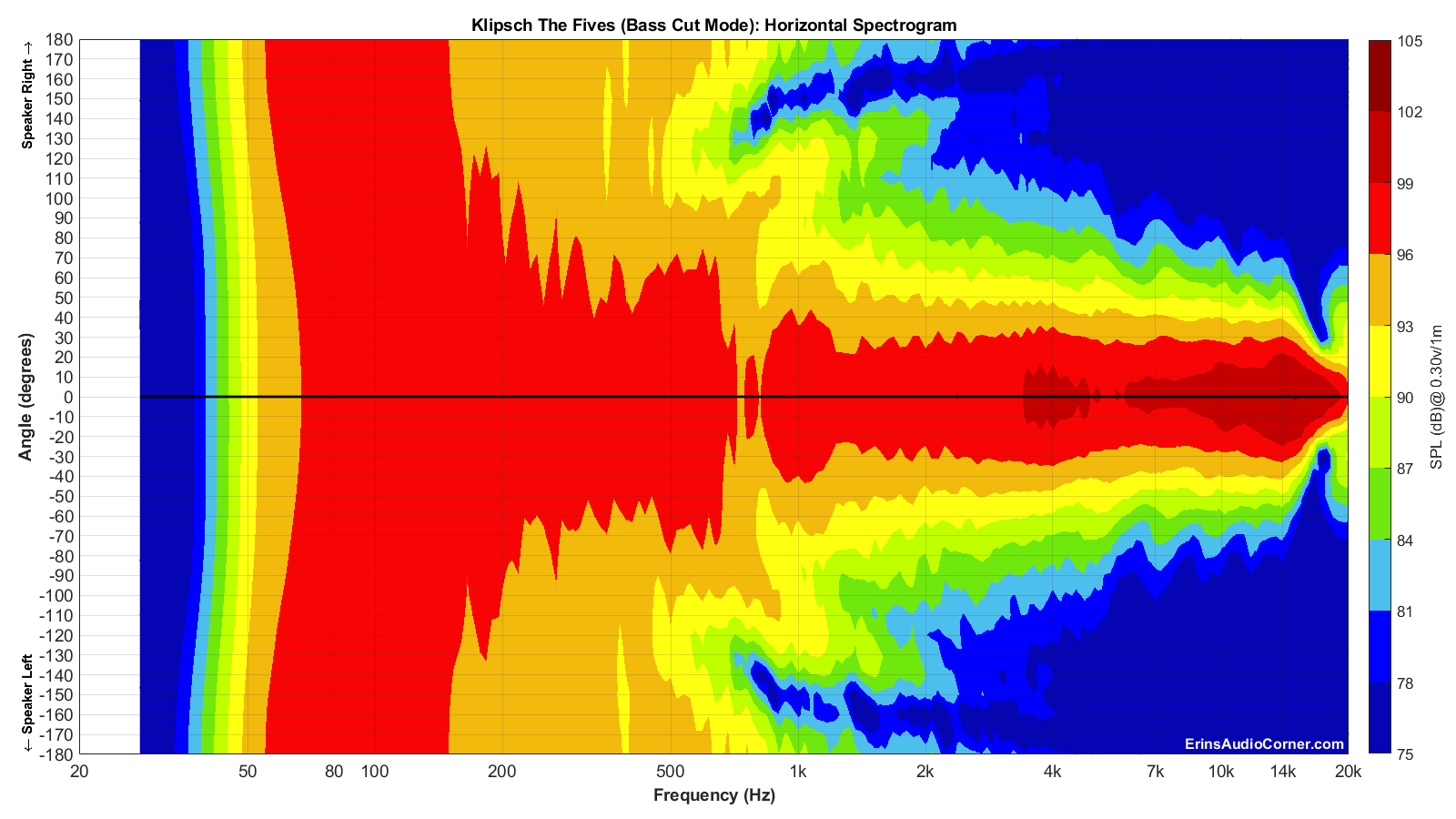
Horizontal Contour Plot (normalized):

Vertical Contour Plot (not normalized):
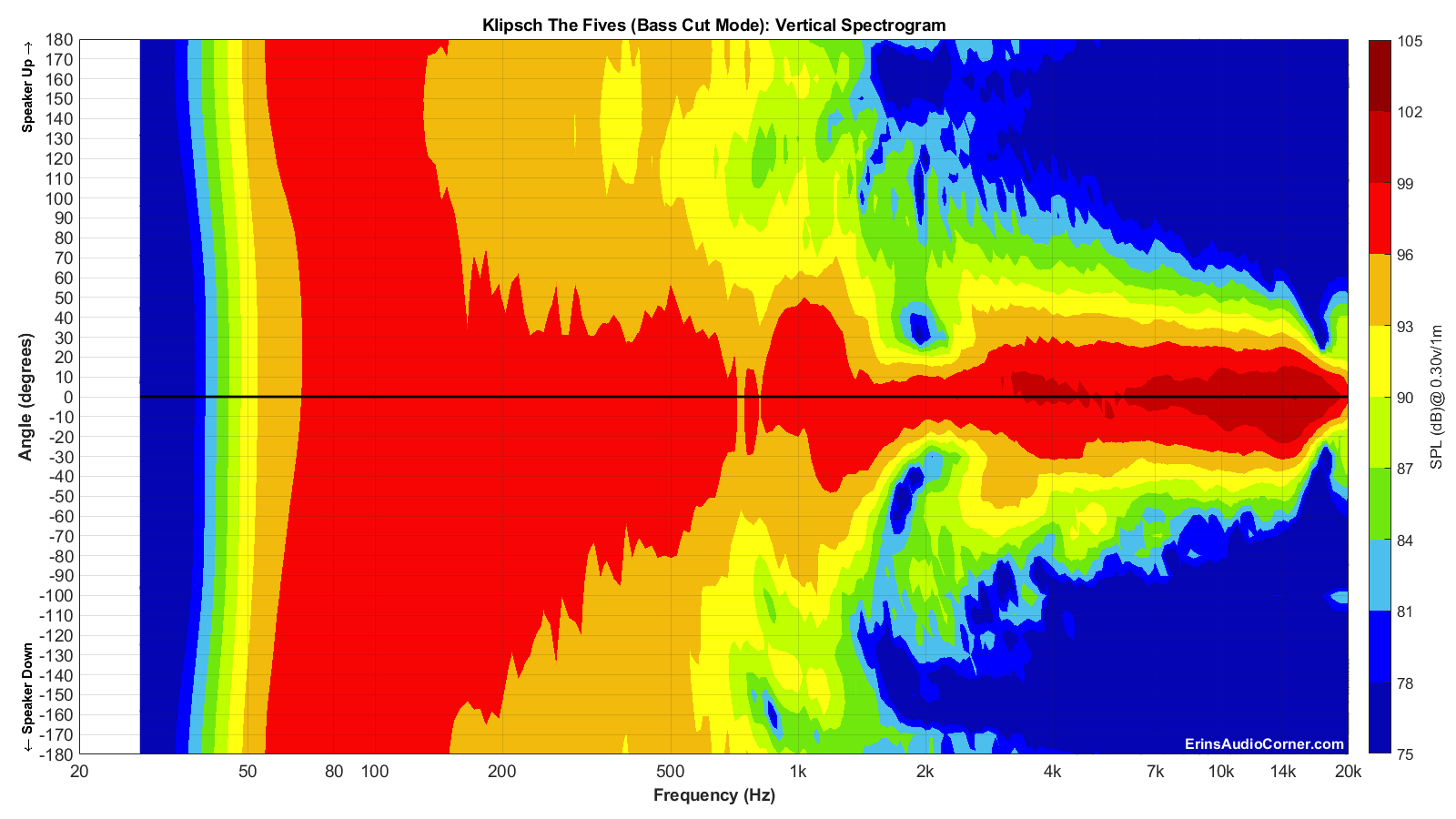
Vertical Contour Plot (normalized):
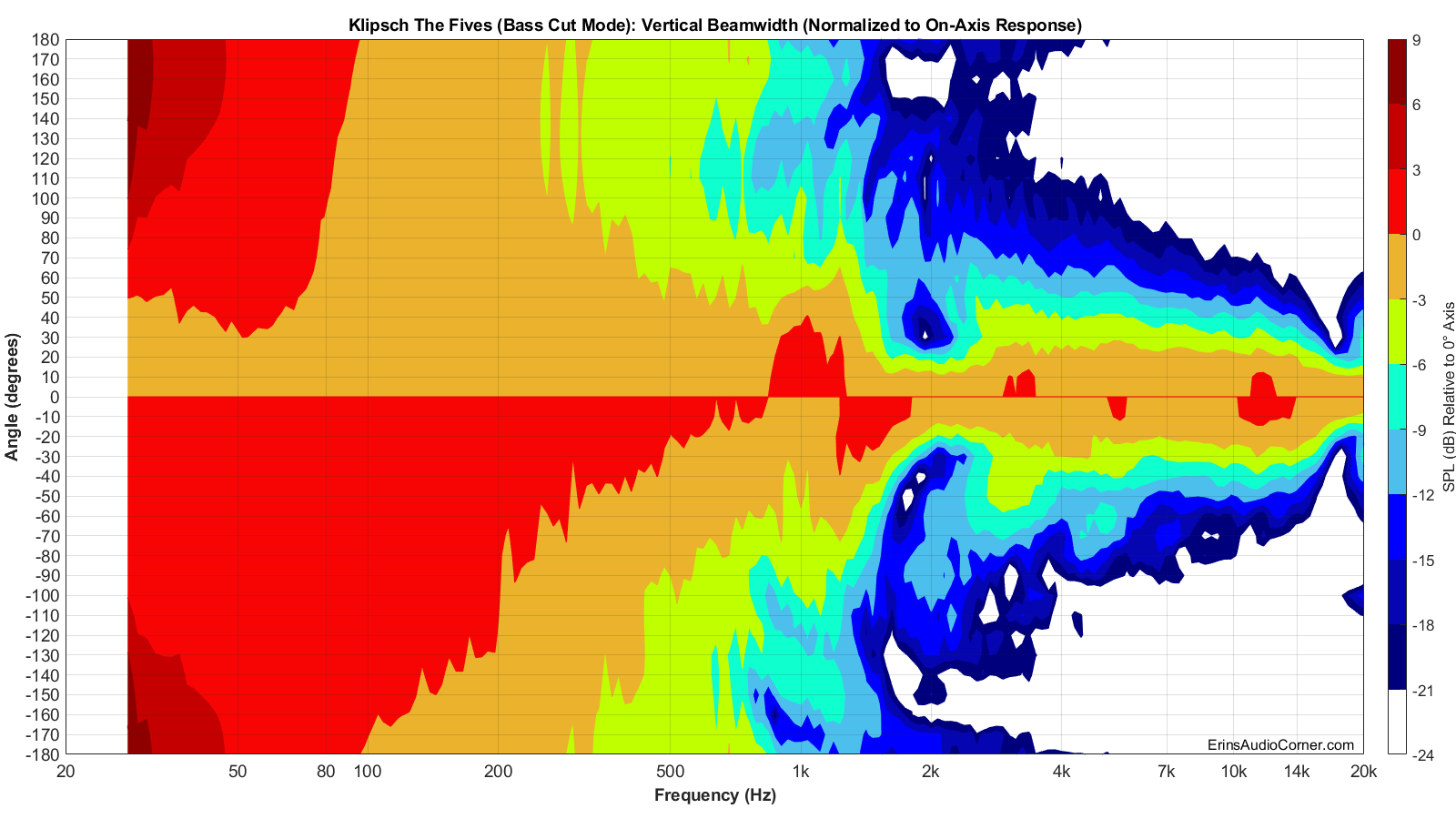
Additional Measurements
On-Axis Response Linearity
Response linearity is -2.45/+4.86 dB (80Hz to 16kHz).
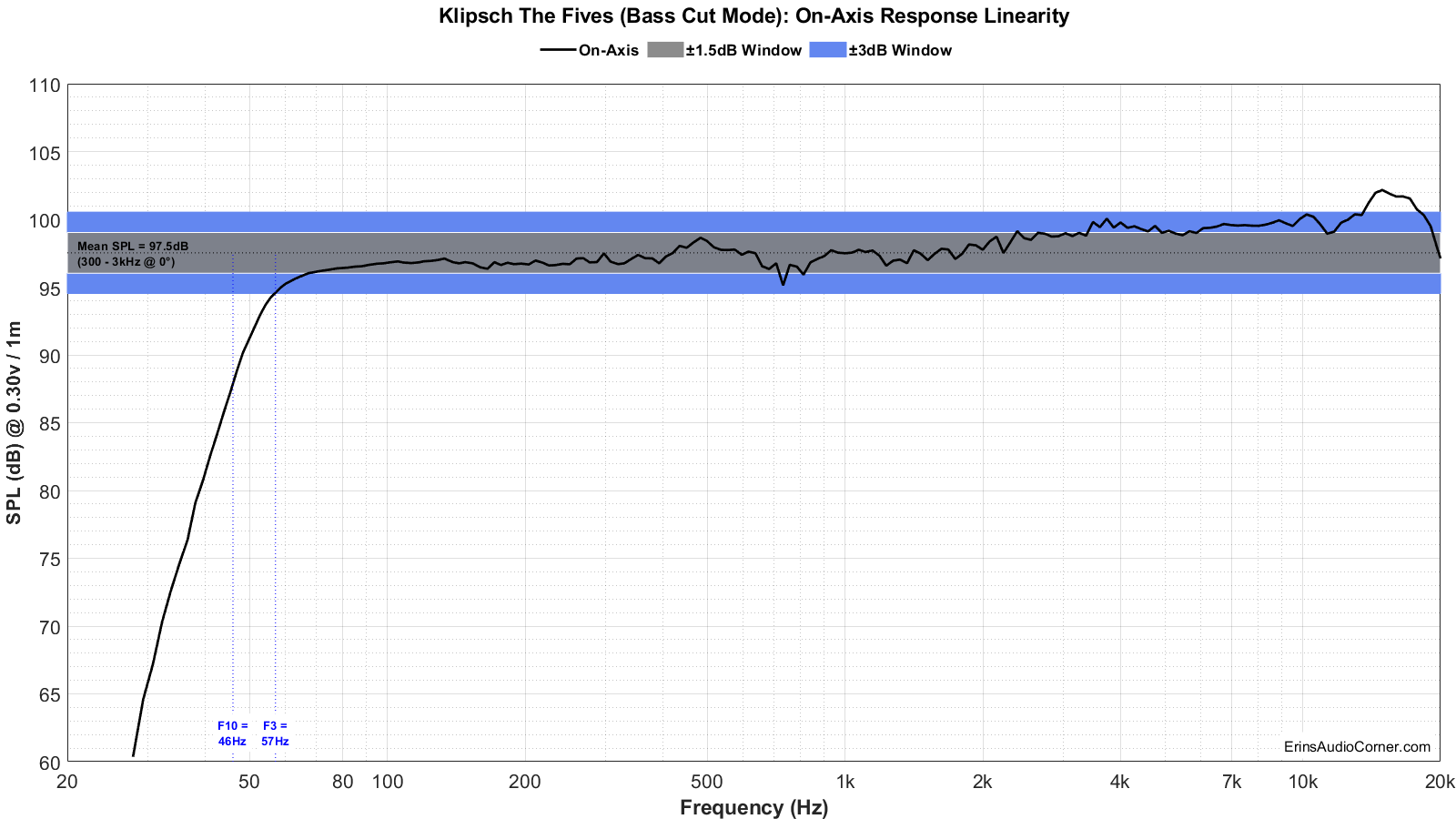
“Globe” Plots
These plots are generated from exporting the Klippel data to text files. I then process that data with my own MATLAB script to provide what you see. These are not part of any software packages and are unique to my tests.
Horizontal Polar (Globe) Plot:
This represents the sound field at 2 meters - above 200Hz - per the legend in the upper left.
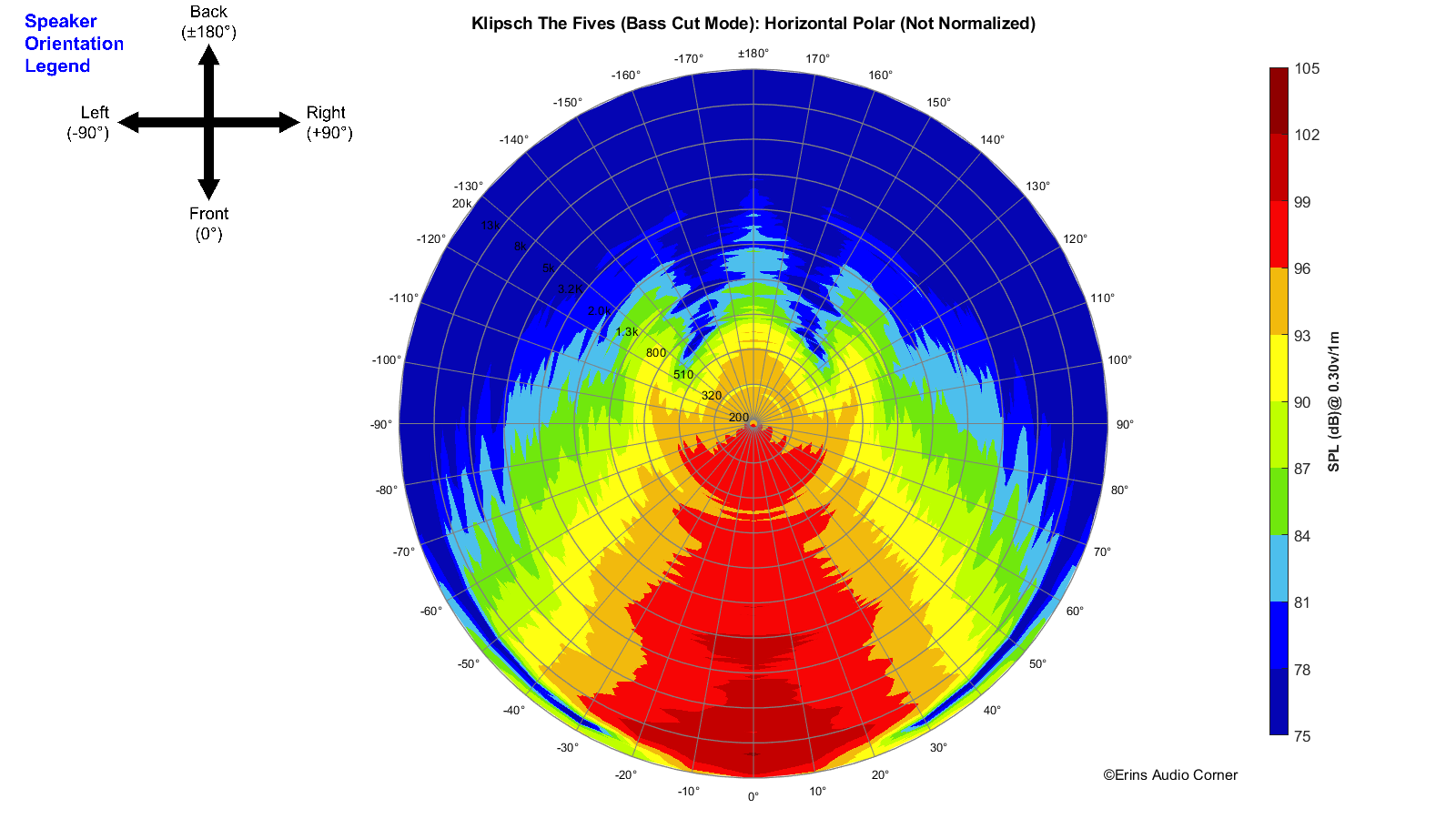
Vertical Polar (Globe) Plot:
This represents the sound field at 2 meters - above 200Hz - per the legend in the upper left.

Harmonic Distortion
Harmonic Distortion at 86dB @ 1m:

Harmonic Distortion at 96dB @ 1m:

Near-Field Response
Nearfield response of individual drive units:

Dynamic Range (Instantaneous Compression Test)
The below graphic indicates just how much SPL is lost (compression) or gained (enhancement; usually due to distortion) when the speaker is played at higher output volumes instantly via a 2.7 second logarithmic sine sweep referenced to 76dB at 1 meter. The signals are played consecutively without any additional stimulus applied. Then normalized against the 76dB result.
The tests are conducted in this fashion:
- 76dB at 1 meter (baseline; black)
- 86dB at 1 meter (red)
- 96dB at 1 meter (blue)
- 102dB at 1 meter (purple)
The purpose of this test is to illustrate how much (if at all) the output changes as a speaker’s components temperature increases (i.e., voice coils, crossover components) instantaneously.
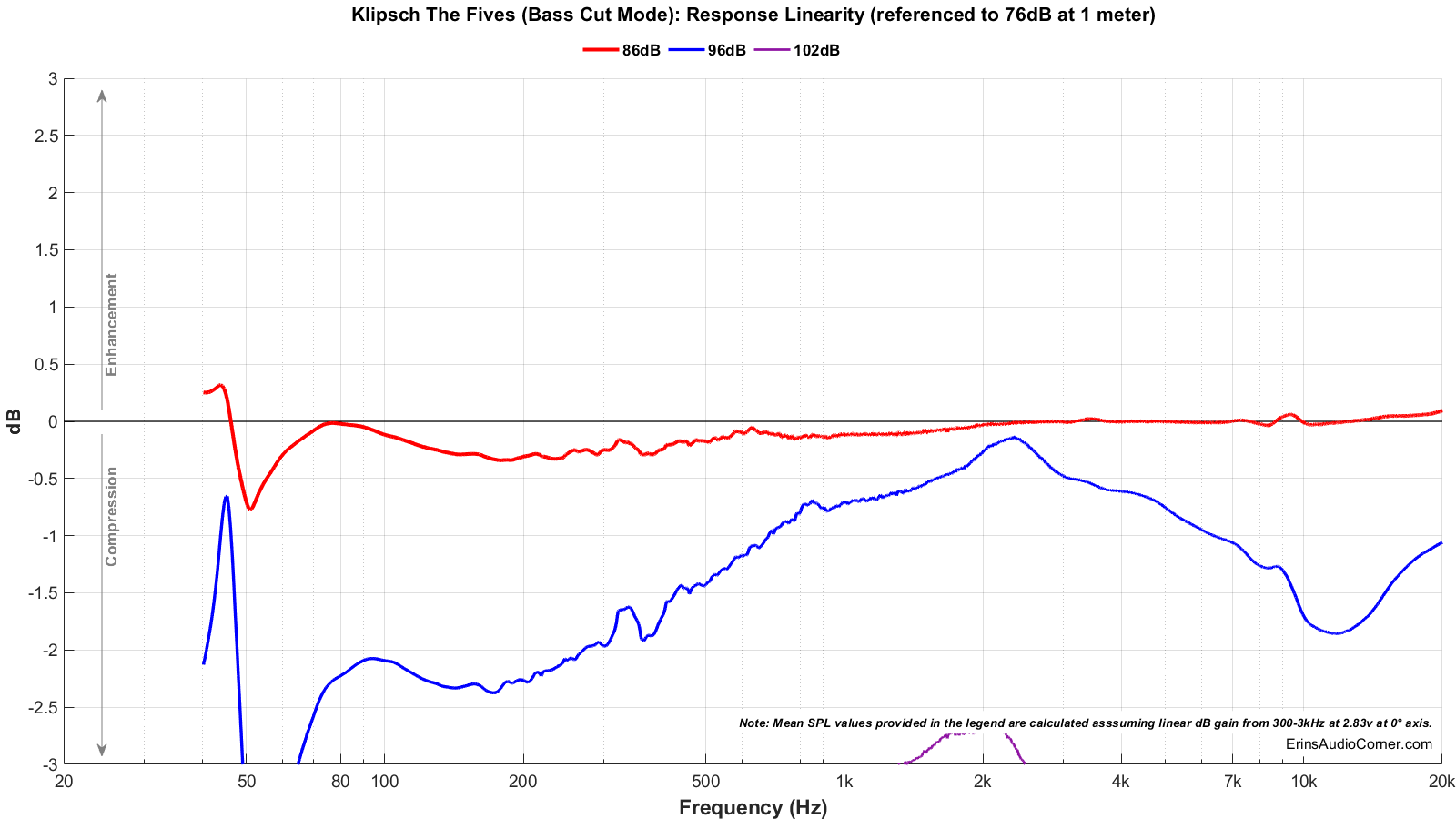
Based on my results above, it is obvious the output is quite limited somewhere above the 86dB @ 1m output level. Both the 96dB and the 102dB show significantly lowered output (>3dB loss of expected gain). This is certainly audible when listening, too, as the bass of the speakers dwindled while the highs remained as I increased the system volume. I haven’t confirmed with Klipsch if this is a built-in limiter, though, I assume it is.
Long Term Compression Tests
The below graphics indicate how much SPL is lost or gained in the long-term as a speaker plays at the same output level for 2 minutes, in intervals. Each graphic represents a different SPL: 86dB and 96dB both at 1 meter.
The purpose of this test is to illustrate how much (if at all) the output changes as a speaker’s components temperature increases (i.e., voice coils, crossover components).
The tests are conducted in this fashion:
- “Cold” logarithmic sine sweep (no stimulus applied beforehand)
- Multitone stimulus played at desired SPL/distance for 2 minutes; intended to represent music signal
- Interim logarithmic sine sweep (no stimulus applied beforehand) (Red in graphic)
- Multitone stimulus played at desired SPL/distance for 2 minutes; intended to represent music signal
- Final logarithmic sine sweep (no stimulus applied beforehand) (Blue in graphic)
The red and blue lines represent changes in the output compared to the initial “cold” test.

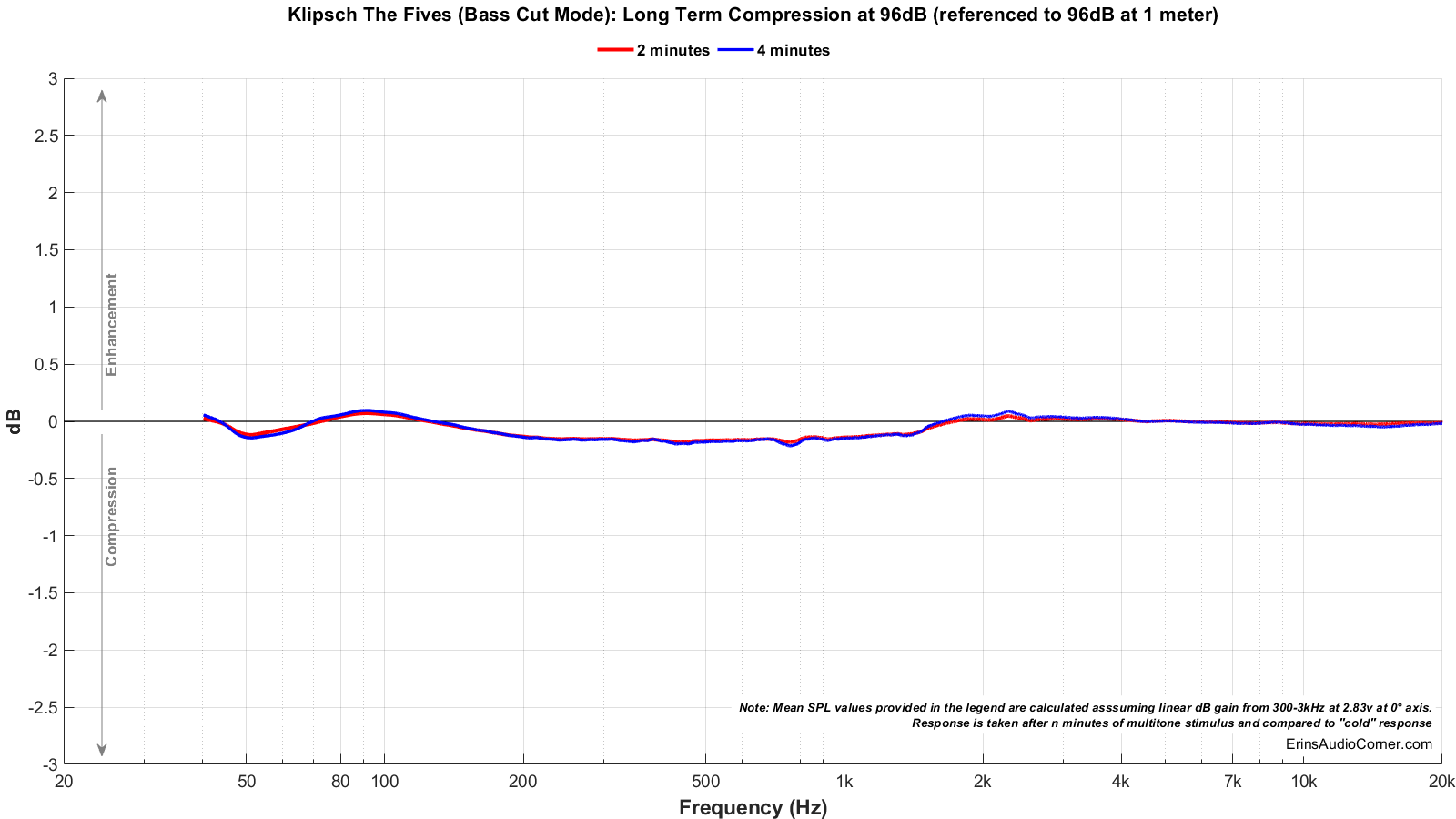
In-Room Measurements from the Listening Position
Below is the actual measured in-room response (with no DSP correction). This is a spatial average taken over approximately 1 cubic foot. The speakers were placed approximately 1.2m from the front wall (not the cabinets; but the actual wall). The listening position was at 4m.
Black = Predicted In-Room Response from SPIN data
Teal = Actual In-Room Measured Response from Main Listening Position at 3.5 meters
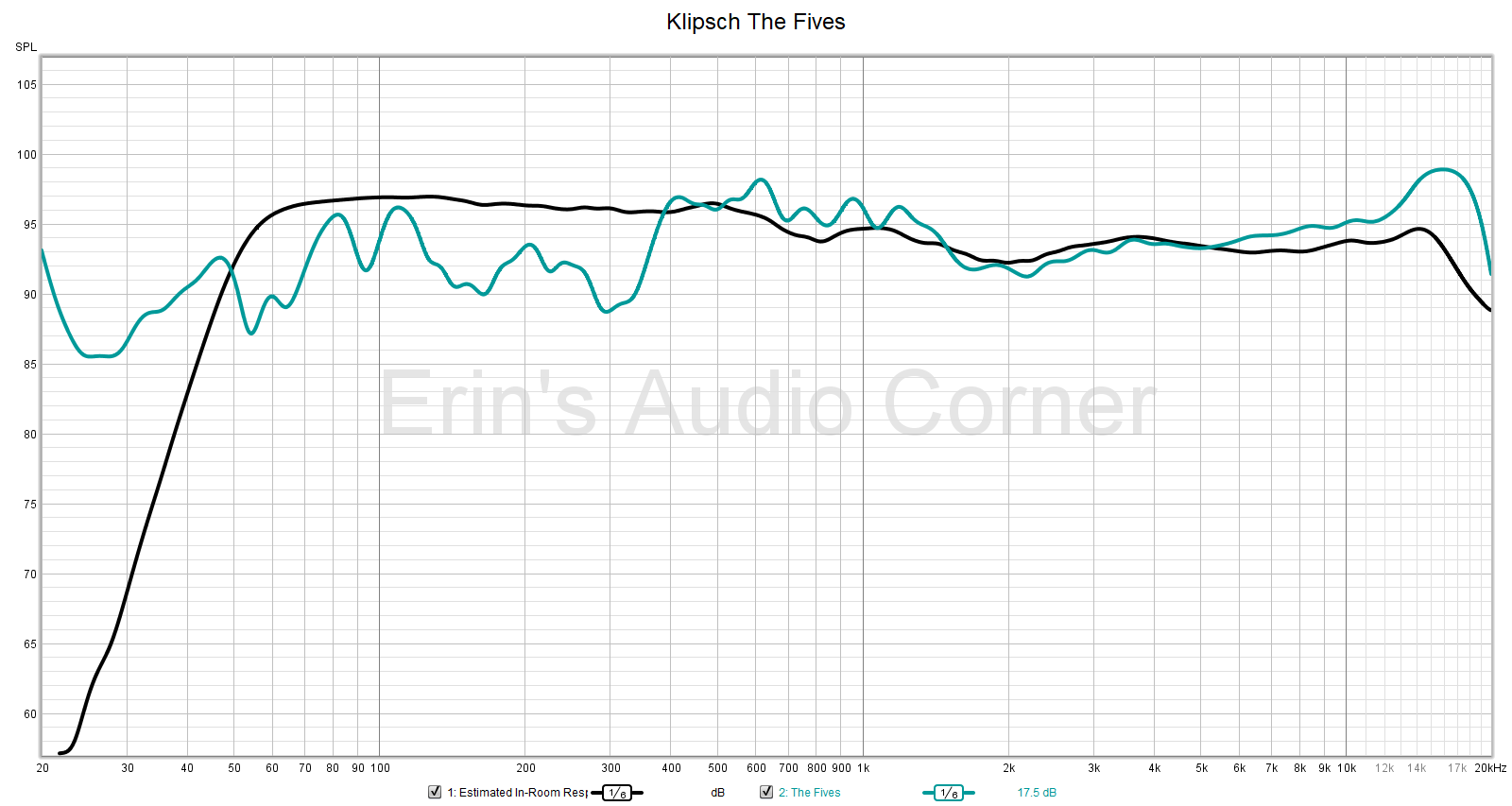
As expected, the predicted in-room response and the actual in-room response line up quite well above approximately 500Hz.
Comparison of “Flat” vs “Bass Cut” DSP Modes
Below is a direct comparison of the on-axis response in the two different modes. As you can see, the “Flat” mode is anything but flat. Ironically, “Bass Cut” mode is flatter.
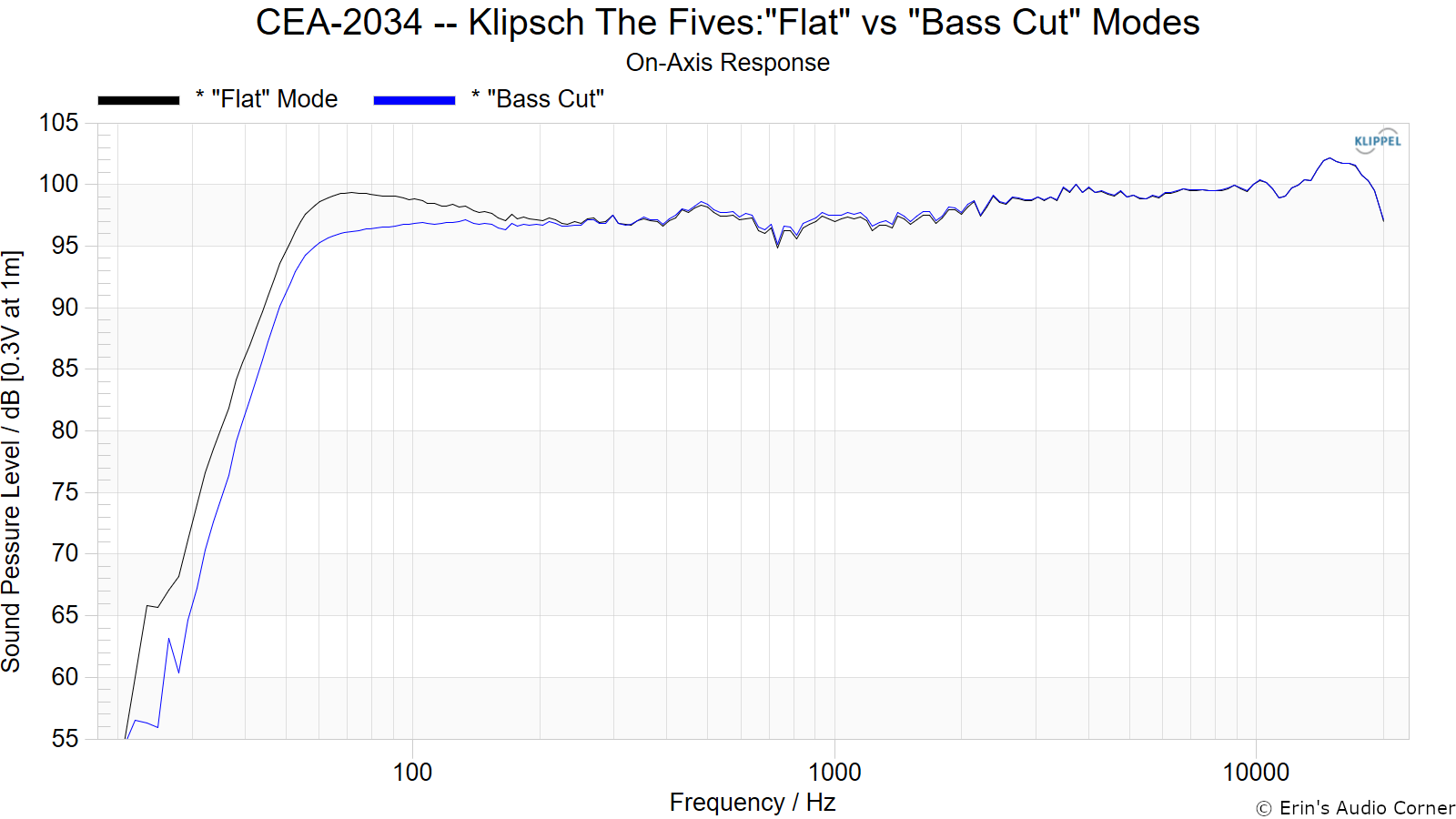
Parting / Random Thoughts
If you want to see the music I use for evaluating speakers subjectively, see my Spotify playlist.
My notes below are based on setting the DSP to “bass cut” mode. When listening in “flat” mode (which isn’t actually flat), the bass was very “thick” and just plain bad. In fact, it was some of the worse midbass I’ve heard from a speaker. Luckily, “bass cut” mode mostly resolved that.
- Subjective listening varied between the nearfield at 1 meter and the farfield at 4 meters but was mostly at the 4 meter mark as these are marketed as being soundbar replacements and my TV is quite far from my main listening position. Subjective listening was conducted at 80-95dB at these distances. Higher volumes were done simply to test the output capability in case one wants to try to sit further away.
- Port resonance once again rears its head and shows itself in the midrange between ~700-800Hz.
- Depeche Mode “Enjoy The Silence” - Clap track sounds a tad forward. Bass is nice and mostly neutral but has a slight “bloom” to it.
- “Higher Love” - Very wide soundstage with effects on the left side. Drumroll gives up ~50Hz; bass roll off here?
- “24k Magic” - Bass sounds fuller at lower volumes (~85dB and below) vs higher levels (> ~90dB @ 4m). Definitely using a limiter here.
- “Magic” - Left “click clock” sound is right at the speaker.
- Soundstage depth is even with the speakers’ depth.
- Sounds a bit “forward” or “shouty” with some tracks ~500-800Hz? (Sledgehammer - “anything” “bring yoooouur blue sky”).
- “Free Fallin” - “too” is forward (2-4kHz?). When he hangs his notes in “freeeeee” you can hear more resonance in the 300Hz region (or so).
- High frequency upward tilt is noticeable but harder to tell without a proper A/B, thanks to the smooth shape. Presents itself as a bit bright and sibilant, though.
- The limiter’s effect is certainly noticeable. At low-to-mid volumes the bass is neutral and nice but as volume is increased the bass is limited while the high frequencies continue to increase causing a very strong imbalance in the timbre of the overall presentation and can become quite fatiguing. This would present itself as a problem when watching TV or movies for extended periods of time.
While this speaker isn’t necessarily my taste in overall response, I will say it is a surprisingly pleasant departure from the typical “Klipsch sound” I am used to. At least when the “bass cut” DSP mode is activated. The high frequency rise in response is smooth enough that it doesn’t stand out in a glaring way and I believe that some people may actually like this rise in response as it is more akin to a high frequency tone control, reaching about +3dB from 2kHz to 12kHz.
For those who like a “v-curve” response, you may find the “flat” DSP setting more to your liking. However, I was surprised when I saw just how many others commented on “bloated” bass. As I stated in the intro, I believe this is why Klipsch introduced the firmware update to implement the “bass cut” option, which flattens the bass and makes a noticeable improvement in my opinion.
If Klipsch would allow users the ability to shelve the high frequency via a simple tonal balance you could achieve a fairly flat on-axis response which would put this speaker in a higher performance category for my personal tastes. Of course, if you do intend to use these as a soundbar replacement you are likely to place the speaker off-axis vertically and the high frequency boost may prove beneficial. It comes down to your personal tastes and/or use as these are designed to fit a unique niche. And that brings up another aspect. There are numerous inputs with these speakers such as HDMI ARC, toslink, RCA, 3.5mm aux and Bluetooth. All these features paired with the small size and supplied remote make these a worthy consideration if you are indeed looking for a soundbar replacement.
Remember, these implement a pretty restrictive limiter to cut the bass and midrange when the SPL increases between 86dB and 96dB @ 1 meter. So, if you plan to sit far away from your speakers this may be an issue. Ideally, I would expect 2 to 3 meters listening distance would be the maximum for most people before the limiting is an issue.
As with anything else, I suggest purchasing these from a retailer who offers a return policy so you can try these out in-home. If you’re in search of such a retailer, please consider using my B&H affiliate link below.
As stated in the Foreword, this written review is purposely a cliff’s notes version. For more details about the performance (objectively and subjectively) please watch the YouTube video.
Support the Cause
If you like what you see here and want to help support the cause you might be interested in joining my Patreon, here. You can also contribute via PayPal (the big yellow button below).
Your support helps me pay for new items to test, hardware, miscellaneous items and costs of the site’s server space and bandwidth. All of which I otherwise pay out of pocket. So, if you can help chip in a few bucks, know that it is very much appreciated.
Alternatively, if you are interested in purchasing these speakers, please consider using my B&H affiliate link below. It yields me a small commission at no additional cost to you and allows me to keep doing what I am doing.
You can also join my Facebook and YouTube pages if you would like to follow along with updates.